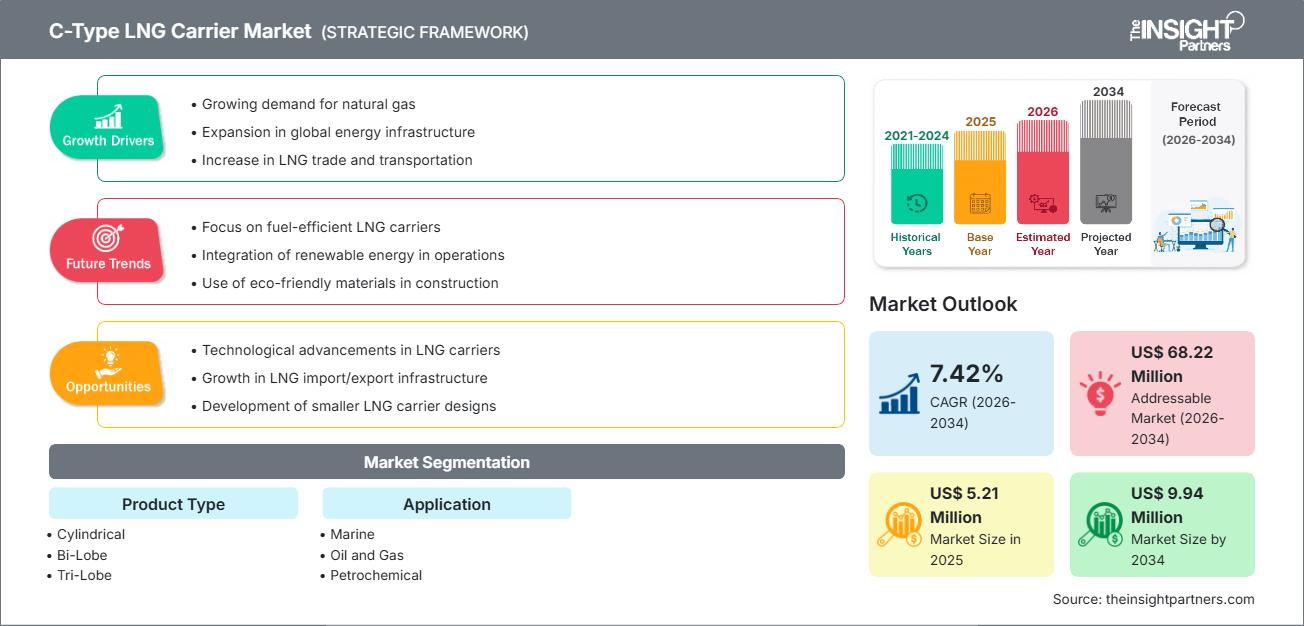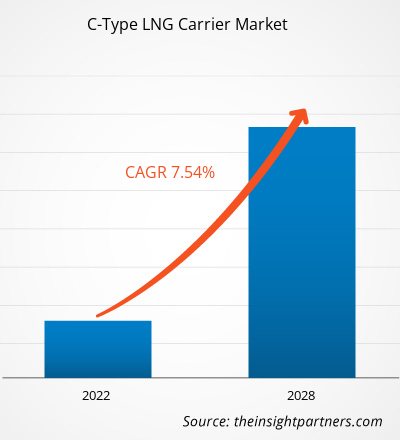C型LNG运输船市场规模预计将从2025年的521万美元增长到2034年的994万美元。预计该市场在2026年至2034年期间的复合年增长率将达到7.42%。
C型液化天然气运输船市场分析
由于全球对天然气作为更清洁的过渡燃料的需求不断增长,以及全球液化天然气(LNG)基础设施的扩张,C型LNG运输船市场正在蓬勃发展。C型运输船采用隔热的全压或部分压圆柱形、双叶形或三叶形储罐,主要用于中小型LNG运输船和其他液化气体运输。它们在促进国际LNG贸易方面发挥着至关重要的作用,尤其是在区域分销、加注和偏远地区供应方面。推动市场增长的因素包括:新的液化项目、LNG动力船舶新造船合同的激增,以及为支持不断增长的小型LNG市场而对更通用型运输船的需求。
C型液化天然气运输船市场概览
C型液化天然气运输船是一种专门用于在低温下运输液化天然气(LNG)的船舶。“C型”指的是其围护系统,该系统由独立的圆柱形、双叶形或三叶形压力容器组成,通常安装在船体内部。这种设计提高了结构完整性和货物装卸灵活性,使其成为中小型LNG运输的理想选择。该市场的特点是技术进步,致力于提高燃油效率和环境可持续性,例如采用双燃料发动机。
根据您的需求定制此报告
您可以免费获得任何报告的定制服务,包括本报告的部分内容、国家/地区层面的分析、Excel 数据包,以及面向初创企业和高校的优惠折扣。
C型液化天然气运输船市场:战略洞察

-
获取本报告的主要市场趋势。这份免费样品将包含数据分析,内容涵盖市场趋势、估算和预测等。
C型液化天然气运输船市场驱动因素和机遇
市场驱动因素:
- 全球液化天然气产能不断增长:全球液化工厂和出口产能的扩张,尤其是在北美和俄罗斯等地区,使得运输船对将不断增加的液化天然气供应输送到消费地区的持续需求不断增加。
- 多个行业对天然气的需求不断增长:天然气作为一种更清洁的化石燃料替代品,越来越多地被用于发电、工业应用以及作为船舶燃料(液化天然气加注),这直接推动了对必要运输船舶的需求。
- 新造船合同激增和新船队扩张:为遵守环境法规(如 IMO 2023 年温室气体减排措施)而需要对船队进行现代化改造,以及液化天然气动力船舶船队(包括集装箱船和渡轮)的扩张,推动了 C 型和其他液化天然气运输船的新订单。
市场机遇:
- 小型液化天然气市场蓬勃发展:C型运输船是小型液化天然气市场的理想选择,该市场主要面向偏远地区、工业客户以及提供液化天然气作为船用燃料(加注)。区域液化天然气分销网络的扩展带来了巨大的市场机遇。
- 船舶设计技术进步:开发和集成新技术的机会很多,例如更节能环保的船舶设计,以及用于船舶优化、预测性维护和实时数据分析的人工智能和数字系统,以降低运营成本和环境影响。
- LNG 基础设施的扩张:全球对新的进口码头、再气化设施和 LNG 加注中心的投资,为 C 型运输船服务这些新的基础设施点创造了机会。
C型LNG运输船市场报告细分分析
本报告对C型LNG运输船的市场份额进行了多维度分析,旨在更清晰地了解其市场结构、增长潜力及新兴趋势。以下是大多数行业报告中常用的标准细分方法:
按产品类型:
- 圆柱形
- 双叶
- 三叶
按申请方式:
- 海洋
- 石油和天然气
- 石油化工
按地理位置:
- 北美
- 欧洲
- 亚太
- 南美洲和中美洲
- 中东和非洲
C型LNG运输船市场区域洞察
The Insight Partners 的分析师对预测期内影响 C 型 LNG 运输船市场的区域趋势和因素进行了详尽的阐述。本节还探讨了北美、欧洲、亚太、中东和非洲以及南美和中美洲等地区的 C 型 LNG 运输船市场细分和地域分布情况。
C型液化天然气运输船市场报告范围
| 报告属性 | 细节 |
|---|---|
| 2025年市场规模 | 521万美元 |
| 到2034年市场规模 | 994万美元 |
| 全球复合年增长率(2026-2034 年) | 7.42% |
| 史料 | 2021-2024 |
| 预测期 | 2026-2034 |
| 涵盖部分 |
按产品类型
|
| 覆盖地区和国家 |
北美
|
| 市场领导者和主要公司简介 |
|
C型液化天然气运输船市场参与者密度:了解其对业务动态的影响
C型液化天然气运输船市场正快速增长,这主要得益于终端用户需求的不断增长,而终端用户需求的增长又源于消费者偏好的转变、技术的进步以及对产品优势认知的提高。随着需求的增长,企业不断拓展产品和服务,持续创新以满足消费者需求,并把握新兴趋势,这些都进一步推动了市场增长。

- 获取C型LNG运输船市场主要参与者概览
C型LNG运输船市场份额地域分析
预计亚太地区在预测期内将持续增长,并占据最大的市场份额。这一主导地位归功于该地区对天然气的巨大且不断增长的需求、高速的工业增长以及清洁能源的普及应用。中国是主要的市场贡献者,但其船队仍然高度依赖外国液化天然气运输船。
由于新造船合同激增和船队扩张等因素,C型LNG运输船市场在各地区的增长轨迹各不相同。以下是各地区市场份额和趋势概述:
-
北美
- 市场份额:凭借其作为主要液化天然气出口国的地位,占据了相当大的市场份额。
-
关键驱动因素:
- 美国和加拿大液化天然气出口能力大幅扩张。
- 主要液化天然气生产商的存在以及航运业对液化天然气资产的强劲投资。
- 重点发展液化天然气作为清洁能源。
- 趋势:对国内液化天然气运输资产(如液化天然气加注驳船)的投资。
-
欧洲
- 市场份额:液化和再气化能力不断提升,这是一个重要的市场。
-
关键驱动因素:
- 重点关注能源安全和天然气供应多元化。
- 更严格的环境法规(例如国际海事组织规则)正在加速采用液化天然气动力船舶。
- 对现有液化天然气进口终端的新服务(例如,小规模配送)的需求。
- 趋势:投资建设新的液化天然气运输船,包括用于北极航线的破冰船,并转向双燃料和符合环保标准的船舶。
-
亚太地区
- 市场份额:由于液化天然气进口需求巨大,预计将成为增长最快的区域市场,并占据相当大的市场份额。
-
关键驱动因素:
- 工业快速发展和能源需求不断增长。
- 政府支持采用液化天然气等更清洁的能源。
- 液化天然气进口量巨大,尤其是在中国和印度。
- 趋势:船舶领域在应用方面占据主导地位。高度重视再气化能力的建设。
-
南美洲和中美洲
- 市场份额:新兴市场,市场接受度不断提高。
-
关键驱动因素:
- 能源需求不断增长和天然气田的开发。
- 投资区域液化天然气基础设施和进口设施。
- 趋势:面向多语言受众的自动翻译工具的开发、用于广告系列优化的预测性人工智能以及社交聆听平台。
-
中东和非洲
- 市场份额:新兴市场,具有强劲的增长潜力。
-
关键驱动因素:
- 国家重大数字化和能源战略促进天然气运输领域的创新。
- 卡塔尔等主要参与者继续主导全球液化天然气贸易,推动对新运输船的需求。
- 趋势:基于人工智能的受众情绪追踪、影响者欺诈检测以及通过机器学习进行多语言内容审核。
C型液化天然气运输船市场参与者密度:了解其对业务动态的影响
C型液化天然气运输船市场竞争异常激烈,少数几家大型全球造船和航运公司主导着新船订单和船队运营。企业实现差异化的主要途径是技术创新、遵守严格的环境法规以及战略性的船队管理。
竞争格局促使供应商通过以下方式实现差异化:
- 投资先进的防护系统和节能推进系统,以减少燃料消耗和排放。
- 造船商、技术供应商和大型能源公司之间的合作,旨在为新船获得长期合同和融资。
- 瞄准市场中日益增长的细分领域,该领域需要更小、更多功能的 C 型运输船,用于区域配送和加油服务。
机遇与战略举措
- 船队现代化和扩建:各公司不断订购新船,以取代老旧、效率较低的船舶,并扩大产能,以满足不断增长的全球液化天然气贸易量。
- 一体化价值链:大型能源公司和大型航运公司正在整合其在整个液化天然气价值链中的业务,从液化到运输和分销。
- 采用数字化和自主技术:开发和集成智能航运解决方案(人工智能、物联网、远程监控),以提高运营效率、安全性和预测性维护。
在C型LNG运输船市场运营的主要公司有:
- 中国船舶贸易有限公司
- 大宇造船株式会社
- GAS Entec
- Gaslog有限公司
- 现代三湖重工有限公司
- 克努森OAS航运
- 科马林公司
- 三菱重工有限公司
- TGE Marine Gas Engineering GmbH
免责声明:以上列出的公司不分先后顺序。
C型液化天然气运输船市场新闻及最新进展
- 例如,2024年11月,HD KSOE宣布与位于欧洲、大洋洲、亚洲和中东的海外公司签署了共计25艘船舶的造船合同。这些合同包括两艘超大型氨运输船(VLAC)、15艘中型成品油运输船(PC)、六艘超大型液化石油气运输船(VLGC)和两艘液化天然气(LNG)运输船。合同总金额为2.82万亿韩元。
C型液化天然气运输船市场报告涵盖范围及成果
《C型LNG运输船市场规模及预测(2021-2034)》报告对市场进行了详细分析,涵盖以下领域:
- C型LNG运输船市场规模及预测,涵盖全球、区域和国家层面的所有关键市场细分领域。
- C型LNG运输船市场趋势,以及驱动因素、制约因素和关键机遇等市场动态
- 详细的PEST和SWOT分析
- C型LNG运输船市场分析,涵盖关键市场趋势、全球和区域框架、主要参与者、法规以及近期市场发展动态。
- C型LNG运输船市场行业格局及竞争分析,涵盖市场集中度、热力图分析、主要参与者及最新发展动态。提供详细的公司简介。
- 历史分析(2 年)、基准年、预测(7 年)及复合年增长率
- PEST和SWOT分析
- 市场规模、价值/数量 - 全球、区域、国家
- 行业和竞争格局
- Excel 数据集
近期报告
客户评价
购买理由
- 明智的决策
- 了解市场动态
- 竞争分析
- 客户洞察
- 市场预测
- 风险规避
- 战略规划
- 投资论证
- 识别新兴市场
- 优化营销策略
- 提升运营效率
- 顺应监管趋势






















 获取免费样品 - C型液化天然气运输船市场
获取免费样品 - C型液化天然气运输船市场